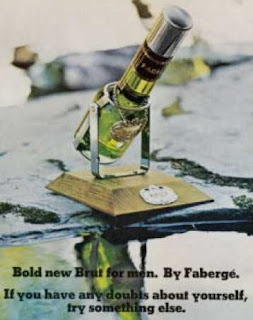In our last post, we journeyed with the fabled Fabergé name from the royal court of St. Petersburg to the corner drugstore in America. Yet there is one more chapter to be told of this name finding a home on Main Street, USA.
In 1984, George Barrie sold Fabergé Inc. for $180 million to McGregor Corp. McGregor, a men's and boys' clothing manufacturer, was controlled by self-made millionaire Meshulam Riklis through his company Rapid America. Riklis was known for his elegant financial mechanisms used to acquire businesses, often placing investors at risk with his leveraged buyouts using junk bonds. However, he was most likely better known to the public for his May-December marriage to the much younger singer, Pia Zadora, and his launching of her career through his business connections and ownership of the Riviera casino in Las Vegas.
In 1985, the company launched a new men’s cologne, McGregor by Fabergé. Part of the distribution network was Rapid-American owned discount department store chain McCrory’s. Fabergé and Billy the Kid children’s wear under the same banner, what would Carl Fabergé have thought?
Unlike Barrie, Riklis did not seem to be interested in promoting Fabergé with celebrities and growing the brand, rather using the venerable name’s cash flow and equity to grow his business empire. Later that same year, he took the company private and shortly thereafter, transferred the assets from Rapid to the Riklis Family Corp. This transfer in May, 1986 was virtually cashless as it was paid for by the issuance of non-voting, cumulative preferred stock issued by the newly formed entity.
Mark R. Goldston became President of the new Riklis business and targeted an acquisition, storied American cosmetics brand Elizabeth Arden. Goldston (who would later be involved in the Revlon turnaround) concluded a deal for $725 million to acquire Arden from pharmaceutical giant Ely Lilly & Co. Fabergé Inc. was now valued at $1.2 billion.
In 1989, Fabergé Inc. fell into the sights of a multinational consumer-brand Goliath, the Dutch-British firm Unilever, which during that period of time was building its personal care product portfolio. Unilever had just bought the American business Chesebrough-Ponds in 1987, picking up the marks Aqua-Net, Cutex, Pond’s and Vaseline. Now it paid the Riklis Family Corp. $1.55 billion for Fabergé Inc. Unilever had a new strategic vision for the brand, looking to restore its luster as a name synonymous with luxury.
This brings to a close the American chapter in the Fabergé story, from the family losing the rights to its own name – and by extension, its history – for $25,000 to what was now a cosmetics powerhouse brand with rather common roots heading back to its royal heritage in Europe.
Small pieces of the Fabergé legend were to remain in the US, such as the “House of Igor Carl Fabergé” for Franklin Mint; the Forbes Collection of historic Fabergé in New York City; and the development of the Fabergé-style Vivian Alexander line of egg creations. These will be topics for future posts.


